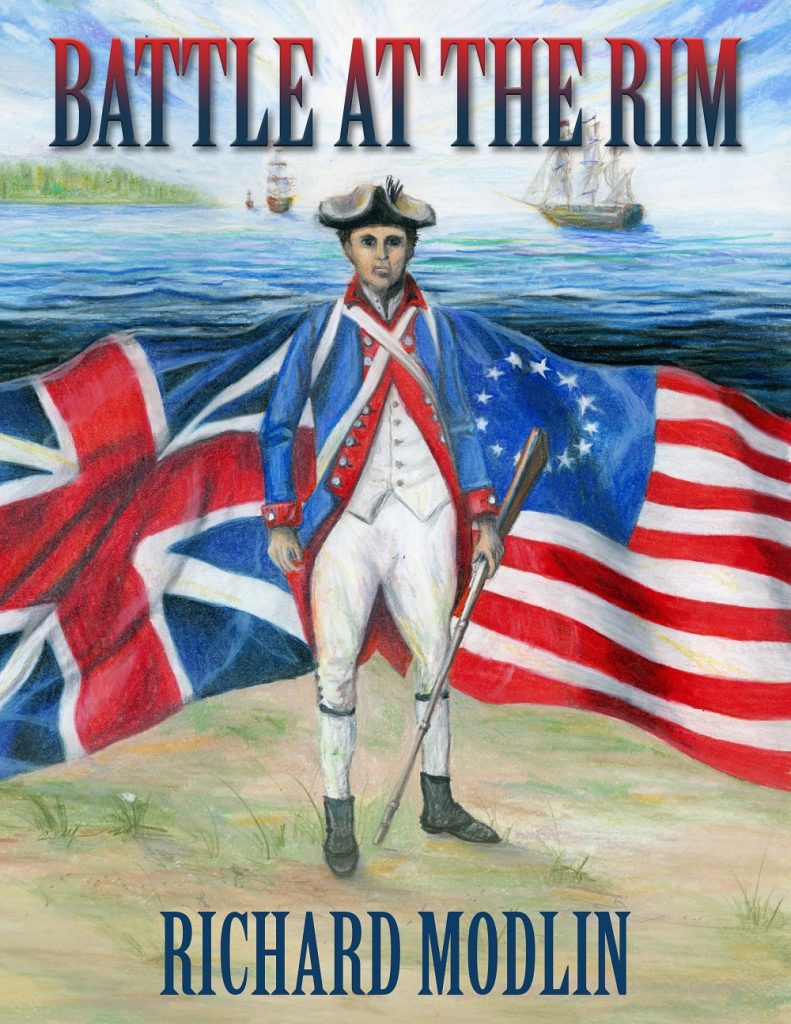
Book Summary
Jack Hollister, an aristocratic Englishman and protagonist in the book, came to the American colonies in 1775, got caught up in the beginnings of the American Revolution, decided to stay and aid the Patriots in their fight for independence.
In Battle at the Rim—this story takes place in 1776-77—George Washington asks Jack to infiltrate the British Military and gather intelligence, because the British are amassing troops to invade Brooklyn and New York City. Jack is clandestinely taken to Staten Island, the staging area for the British, arrested as a possible spy and released because of his birthright. Questioned by British General Howe and his brother, Admiral Howe, Jack provides evidence of who he is and is accepted into the Redcoat military as a lieutenant.
Jack becomes involved in a failed “peace meeting” between the Howes and notable representatives of the Continental Congress. He takes part in the Battle for New York City, and learns Admiral Howe plans to avenge British naval losses due to rebel insurrection in Machias, Maine by bombarding the village. Jack pens a lettered to warn Machias. The letter is sent with the help of a Manny McGully, a patriotic tavern owner. McGully gives a letter sent by Washington to Jack, informing him that his spy service is no longer needed. Jack deserts the Redcoats and, with aid of patriotic colonists and ship captains, makes his way via a circuitous, dangerous—the Redcoats are after him for desertion—overland and nautical route that takes him across Long Island Sound to Connecticut and up the coast to Massachusetts and then to Machias. On the way, he interacts with herring fishermen, local thespians, tavern and inn keepers, a river boater, and an old friend, Captain Horace Smoke.
Reaching Machias, he finds his letter of warning had arrived, but remained unread. Benjamin Foster, colonel of the local militia, reads the letter and calls a meeting of the village leaders. Jack explains his concerns. Machias is fortified, but the militia has few men, so John Allan, area Indian Agent, enlists the help of the local Indian tribes, bringing the complement of Patriots to 100.
Four British warship and 700 marines arrive, attack the fort on the Rim, and head up river to bombard the village. Appearing to be out numbers, because of the visible fortifications around Machias and warlike activity of the Indians, the British retreat. Machias militia battles the British as they escape down river. Machias successfully repels the British siege. Jack is honored for sounding the alert and the assistance he provided.
Four Star ForeWord Clarion Review
This installment of the Jack Hollister series features thrilling elements and clever spycraft that should have universal appeal.
America declared its freedom but now needs to fight to stay free in a surprisingly small-scale historical fiction with larger-than-life characters and stellar writing.
In the early days of the Revolutionary War, the colonials are vastly outnumbered and underpowered. General George Washington receives news of an impending invasion and tasks Jack Hollister with infiltrating the British to feed intel back. As a British-citizen-turned-colonial-ally, Jack’s fate is highly uncertain. He must not only fool the British but also the revolutionaries along the way; despite having Washington on his side, both sides would hang him as a traitor. Thrilling naval battles, sparks of romance, and tense subterfuge tread close behind Jack as he walks a thin line.
The third entry in the Jack Hollister series, Battle at the Rim remains accessible and engaging. Jack is a fantastic character to follow, with ties to both sides of the historical conflict. More importantly, he is flawed and acts believably in any given situation, as when news of Nathan Hale’s execution reaches him. Jack’s initial reaction threatens to expose him as a traitor; later, he crumples in the privacy of his room. The pain of losing his friend highlights Jack’s humanity but also his potential fate should he make even a minor misstep.
Battle at the Rim effectively puts a human face on history, focusing on the day-to-day life of the people. George Washington, Benjamin Franklin, and Nathan Hale are all major characters, but the story shifts the spotlight to Jack and his encounters with the Dutch colonies hoping to stay out of the conflict, the scared recruits on both sides dealing with survival and serving their country, and the strain of a new nation tearing itself apart while fending off a superior enemy.
The writing is fairly polished and does not get too bogged down with unnecessary naval details—an issue inherent to the genre. Should any unfamiliar terms be used, sparse footnotes clarify without muddling the prose. Dialogue shines, with unique accents and speech patterns that make conversations between multiple people flow beautifully. One minor hiccup is when a French-speaking character rapidly switches between French and English without enough context or translation.
Fans of naval and historical fiction should pick up the Jack Hollister series. This installment features thrilling elements and clever spycraft that should have universal appeal.
Reviewed by John M. Murray
August 16, 2017
Disclosure: This article is not an endorsement, but a review. The author of this book provided free copies of the book and paid a small fee to have their book reviewed by a professional reviewer. Foreword Reviews and Clarion Reviews make no guarantee that the author will receive a positive review. Foreword Magazine, Inc. is disclosing this in accordance with the Federal Trade Commission’s 16 CFR, Part 255.
